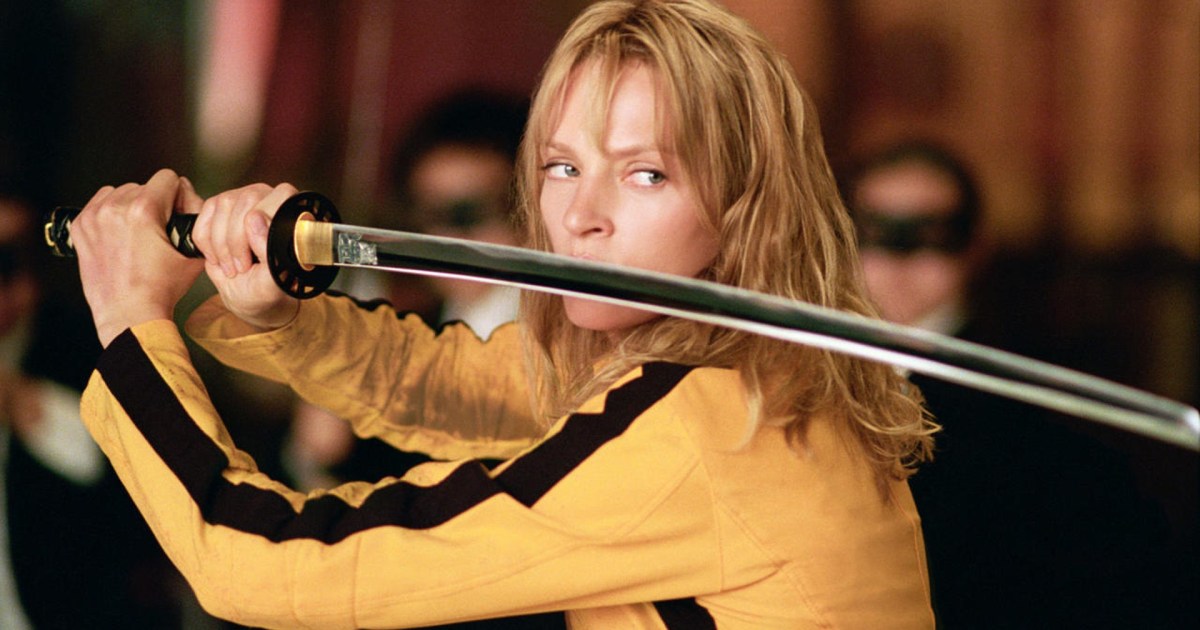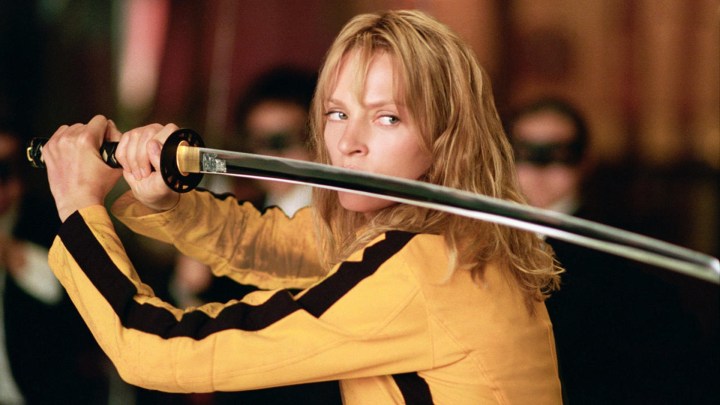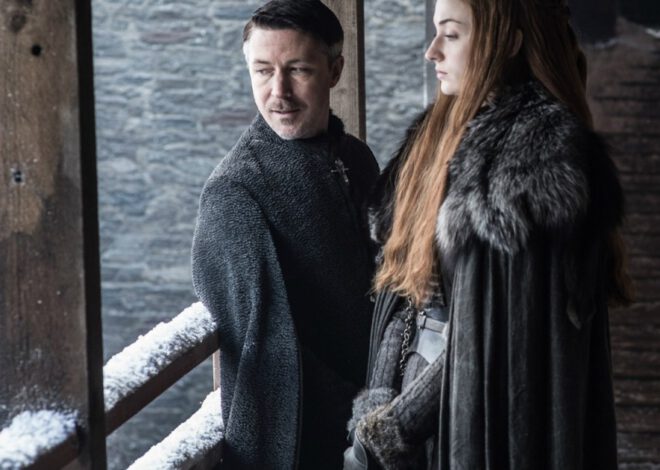
Kill Bill at 20: still Quentin Tarantino’s geekiest pastiche
 Uma Thurman in Kill Bill: Volume 1 Miramax / Miramax
Uma Thurman in Kill Bill: Volume 1 Miramax / Miramax
More than any movie he made before or any he’s made since, Kill Bill looks like an open window into the pleasure center of Quentin Tarantino‘s brain — maybe the closest he’s ever come to getting that overlapping din of genre noise in his head up on the screen. His brilliance has always been closely linked to his taste in movies: Tarantino was a video-clerk scavenger right from the start, building Miramax milestones from the scraps of Hong Kong shoot-’em-ups, ’70s Hollywood crime pictures, or anything else that fed his appetite for sensation. But the writer-director wouldn’t truly disappear into his obsessions until 20 years ago today when he reemerged with the first half of a super-sized revenge opus that took place not in the real world but in some exploitation-movie Twilight Zone best described as Tarantino Land.
For moviegoers of a certain persuasion, the release of Kill Bill: Volume 1 in October of 2003 was an event. It had been six years since Tarantino’s last movie, the funky, bittersweet Elmore Leonard adaptation, Jackie Brown. Over that eternity, the famous QT style had been used, abused, emulated, imitated, and parodied nearly to death. It was bracing to see the genuine article again — to hear dialogue that really snapped, to nod at a needle perfectly dropped, to follow the zigzag of a timeline scrambled with purpose and joy. As Samuel L. Jackson put it in Jackie Brown, accept no substitutes.
Opening to Kill Bill: Volume 1 2004 DVD [True HQ]
Kill Bill announces itself as a retro fetish object immediately, opening with phony vanity cards presenting the film as a “Shawscope” production and promising a “Feature Presentation” of ’70s vintage — the kind of affectations Tarantino would run with in his next film, the double-feature package Grindhouse, made with fellow B-movie enthusiast Robert Rodriguez. These pre-show quirks (coupled with a jokey Star Trek epigraph) set a kitschy throwback tone that Tarantino holds for roughly five seconds, before slamming the audience into Uma Thurman’s bloodied face in a close-up, soon to be blown back by a bullet from her vindictive ex-lover, the eponymous Bill.
On paper, the plot is checklist simple, literally. It follows Thurman’s bereaved Bride as she awakens from a coma and hunts down her betrayers, the codenamed assassins played by the likes of Vivica A. Fox, Lucy Liu, Michael Madsen, Daryl Hannah, and — as Bill himself — David Carradine. But of course, Tarantino doesn’t take such a straight path through the story. He jumps back and forth in time through flashbacks and digressions, organizing the events not chronologically but viscerally or emotionally.
Even more so than in Pulp Fiction, Tarantino structures his movie like a mixtape — and not just because the soundtrack is typically killer, rolling surf rock into country western into an original RZA score into choice motifs from other movies. Spy flicks, kung fu, samurai pictures, French New Wave, ultra-violent anime, Brian De Palma split-screen suspense — Tarantino directs like a one-man festival programmer, curating from his personal library of favorites. Other times, he’s a collector showing off his rarest memorabilia. How else can one categorize the decision to dress Thurman in Bruce Lee’s helmet and iconic yellow tracksuit from Game of Death? Even the casting in a Tarantino movie is an expression of refined tastes, almost a brag. Here, we get martial arts legend Sonny Chiba in the small but pivotal role of a veteran swordmaker.
Kill Bill: Volume 1 | The Bride vs The Crazy 88
Coming as it did after a run of flavorful crime-movie gabfests, Kill Bill also felt like Tarantino’s attempt to hone and demonstrate his craft — to distinguish the director side of his writer-director title. In Pulp Fiction and Reservoir Dogs, the fun was watching B-movie archetypes behave like “normal” people, shooting the shit on the way to a hit, or debating pop culture in a diner. Kill Bill, by contrast, more often lets the action do the talking, and quite spectacularly: Volume 1‘s House of Blue Leaves climax, in which The Bride dispatches a veritable army of armed henchpeople with samurai steel, is as amazing today as it was 20 years ago; the splatter is so hilariously, outrageously gory that Tarantino had to switch to black-and-white to keep an R rating. And Thurman plays an unusually laconic character in the QT canon. It’s a true star performance of Eastwoodian gravity and power that’s now sadly, inevitably colored by the injury she suffered on set and the subsequent fallout between her and Tarantino.
Volume 1 remains the director’s purest blast of no-frills entertainment, maybe the only time he’s really allowed himself to fully geek out. But Tarantino is still too hooked on subversion to play the thrills entirely straight. For one, the achronological architecture of his script deliberately neutralizes some tension: While mixing up the scene order allowed him to effectively resurrect John Travolta’s character in Pulp Fiction (just as the movie would resurrect his career), here it reveals far in advance the outcome of The Bride’s showdown with Liu’s sword-wielding Yakuza boss O-Ren Ishii. At times, Tarantino delivers and he complicates. The first-act, living-room brawl with Fox gets unexpectedly interrupted, leads into a conversation that seems to set up a more ceremonious duel later, and then resolves itself with swift, brutal violence.
Kill Bill: Vol. 1 (1/12) Movie CLIP – Hello Vernita (2003) HD
Released the following spring, Volume 2 would push the subversions further, to some extent almost in response to Volume 1: After staging some of the most remarkable action of the 2000s, Tarantino slows down, withholds, and works around viewer expectations. One villain gets offed by another, instead of by The Bride. And the big final showdown turns into… a very long Tarantino conversation, with the actual fight resolved in mere seconds. The two halves of Kill Bill are so radically different in pacing and tone — an Eastern followed by a Western that’s a deliberate counterpoint of anti-climax — that it’s almost difficult to believe that they were ever intended to be one movie.
There are those who swear Volume 2 is the better film. It’s probably the bolder of the two, and the more emotionally satisfying. But it doesn’t have the dazzling pleasures of Volume 1, powered by Tarantino’s ecstatically playful filmmaking. It’s like a great DJ set, always moving you from high to high. It also feels like a syllabus modeled on Tarantino’s genre education: You can see the logic of how one detour leads into another — a journey an intrepid viewer could embark upon with the film as their reference guide, allusions pointing the way forward.
Kill Bill Vol.1 – Making Of
Of course, Kill Bill also pointed a new way forward for Tarantino, who would stay willfully entangled in his own cinematic obsessions. With the possible exception of the more marginally grounded Once Upon a Time… in Hollywood, all of the films he made afterward are pure pastiche, playing out in an alternate movie world informed by the classics and cult curiosities the filmmaker lives and breathes. It’s possible to admire the playground Tarantino has built for himself and his collaborators, while still pining a little for what he accomplished with Jackie Brown. Now there was a great movie with one foot firmly planted in reality, instead of the Tarantino Land most of his others dig their heels into.
The Kill Bill movies are available to rent or purchase from the major digital services. For more of A.A. Dowd’s writing, please visit his Authory page.


